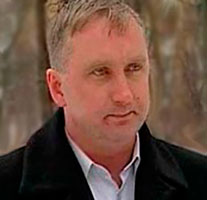Pavel Sapelka: “The prosecutor struggled for the driver-killer like for his own brother”
The driver of the Crysler car, who killed two people by knocking them down while driving, was released from criminal responsibility by the decision of the Investigative Committee and the Prosecutor General's Office.
In the evening of January 20, 2012, when it was dark on the road, the car Chrysler PT Cruiser drove into a group of young people on the roadside near the village of Haradzishcha (Minsk district). As a result, two people died, one of whom was under age. "Conjugate blunt trauma to the head, chest and abdomen, a broken spine and ribs", these are the injuries from which the latter one died.
The father of the deceased, lawyer Pavel Sapelka, told «Yezhednevnik» about the pace of the investigation.
"The car, driven by Aliaksandr Stefanovich, disqualified for driving while intoxicated, crashed into a group of teens without reducing speed”, tells Mr. Sapelka citing a witnesses' words. “He stopped in 150 meters and then continued driving again. Apparently, realizing that fragments of the body were left on the scene of the accident and his car could be identified by them, he decided to return.”
The usual steps started: the traffic police and an ambulance car arrived, a criminal case under part 3 of Article 317 of the Criminal Code " Violation of traffic rules or operation of vehicles, resulting in the death of two or more persons" was instigated. By the way, these actions by the law are punishable by imprisonment from 3 to 7 years.
The case was investigated by the Main Investigation Department of the Investigative Committee of Belarus (MID IC). The same day, an investigator of the Minsk District Department of the Investigation Committee came to the scene to inspect by the stopping distance and time – the data which help answer the main question: whether the driver could avoid the collision, which cost the lives of two people.
There are no doubts in the correctness of his work. However, as the witnesses weren't invited to this process action, the MID IC decided not to use these data in the appointed expert examination.
"The Criminal Process Code allows making such measurements in the absence of witnesses,”, noted Mr. Sapelka. “Even the reference values, which are used by experts in such cases, lead to a clear conclusion: the driver was able to avoid hitting pedestrians by using emergency braking in all cases proposed by the investigator – from 69 to 48,6 meters".
For unknown reasons, these data didn't satisfy the investigator. In the spring he re-appointed the examination. He managed to do it only a year after the accident, when the weather and road conditions resembled those under which the accident occurred.
"I was not informed about this experiment”, continues Mr. Sapelka. “What could not but surprise – the investigator hurried for the first experiment the day after the funeral of my son. After this, I had only to study the documents, after which I began to doubt the objectivity of the agency conducting the preliminary investigation."
According to the results of the second examination it was impossible to prevent the hitting of the people. Mr. Sapelka believes that this conclusion is based on vague facts, and the investigator could not but know about it.
To save space, we present briefly the facts which formed the basis of the subsequent complaints of the human rights defender to MID IC, Prosecutor General's Office and the courts.
During the whole time while the investigator was waiting for the examination, the car, which caused the death of two people was used by the suspect, who earns his living by repairing cars. Thus, he had all opportunities to make any modifications he wanted.
The experiment was attended by just one witness, and the rest were not even invited. This means that experts were given only partial information.
The suspect changed his testimony. A year ago, he insisted that he was moving at a speed of 50 km/h (the witnesses talked about the speed of 100-120 km/h, which violated the speed limit), and then increased it to 60 km/h. According to the driver, he didn't notice the people on the road because he was blinded by an oncoming car (whereas the witnesses that there was no such car at the moment). The suspect reported about reducing speed and stopping(there weren't registered any traits of braking or change of the direction of movement). The driver claimed that he didn't drive after disqualification, though his girlfriend said the opposite.
Nevertheless, such information was enough to dismiss the criminal case.
The father of the deceased thrice appealed this decision at the Prosecutor General's Office, as a result of which the decision to dismiss the case was reversed. Given the conflicting testimonies of the suspect, the investigator suggested the use of reference data in the examination.
However, the intention of Mr. Sapelka to participate actively in the process of investigation met with an unexpected obstacle in the form of MID IC and the Prosecutor General's Office.
"In one of the responses to my petition to Deputy Prosecutor General Aliaksandr arkhipau (now a defendant in a criminal article "Abuse of power or official authority" - Ed.) suddenly stated that the driver should not always decrease the speed and take measures to stop after seeing an obstacle,” says Pavel Sapelka. “Here is the quote, on the basis of which you can safely justify drivers who run over people whom they have taken for bags: "An obstacle for driving is not a dark spot or dark was, but a real obstacle in the form of a pedestrian, whom the driver can see and recognize".
The MID acted in a similar manner. The investigator answered Sapelka's petition for being allowed to participate in all investigative experiments by saying that it was only possible if the victim was an eyewitness of the accident.
"The statement of the law enforcement officer is contrary to Art. 20 of the Criminal-Process Code, according to which suspects, accused, victims, witnesses, experts and the people who hold the expert actions can be driven to the investigative experiment in the case of necessity with their consent”, quotes Pavel Sapelka. “It is ridiculous to hear such a denial for me, a man who has been already drawn to participation in the experiment a few days after the accident. And it is indeed strange that all my applications were met so negatively by the law enforcement agencies. The matter is not only that one could listen to the request of a father whose son was killed, but also that I have worked in the law system for twenty years and cannot be cheated like some other party in the case."
Mr. Sapelka completely realized that the mail correspondence with the Prosecutor General's Office and the Main Investigation Bureau turns into runarounds when another deputy prosecutor issued a protest against the decision of the court to quash the termination of criminal proceedings.
"My idea of legitimacy is not based on fantasy and blind hatred of the suspect, but on an objective analysis of the data of the criminal case, collected by the investigator”, states the lawyer. “Unlike the prosecutors and the Investigative Committee, I am really interested in objective investigation".
However, there will be no investigation. The case was dismissed.


















